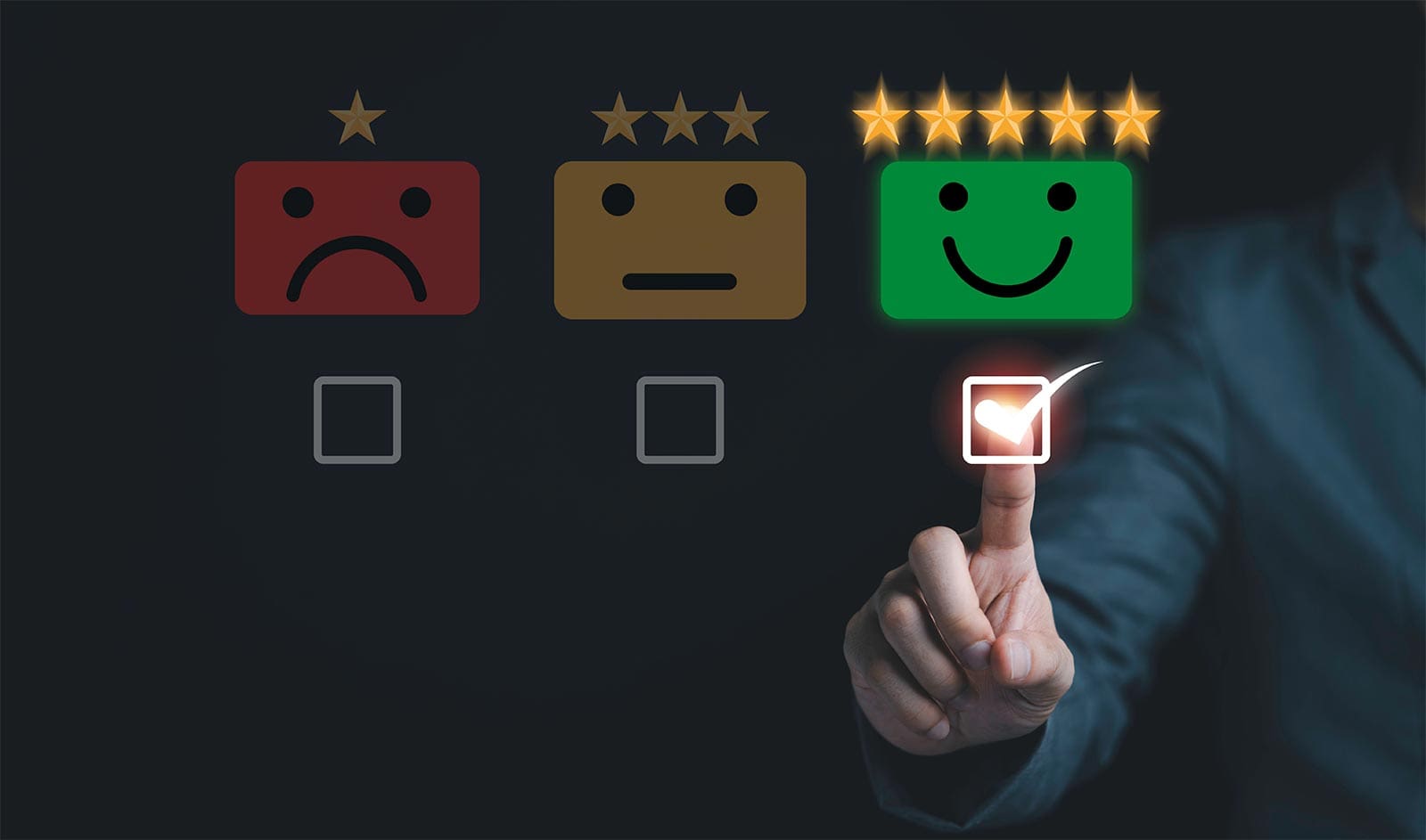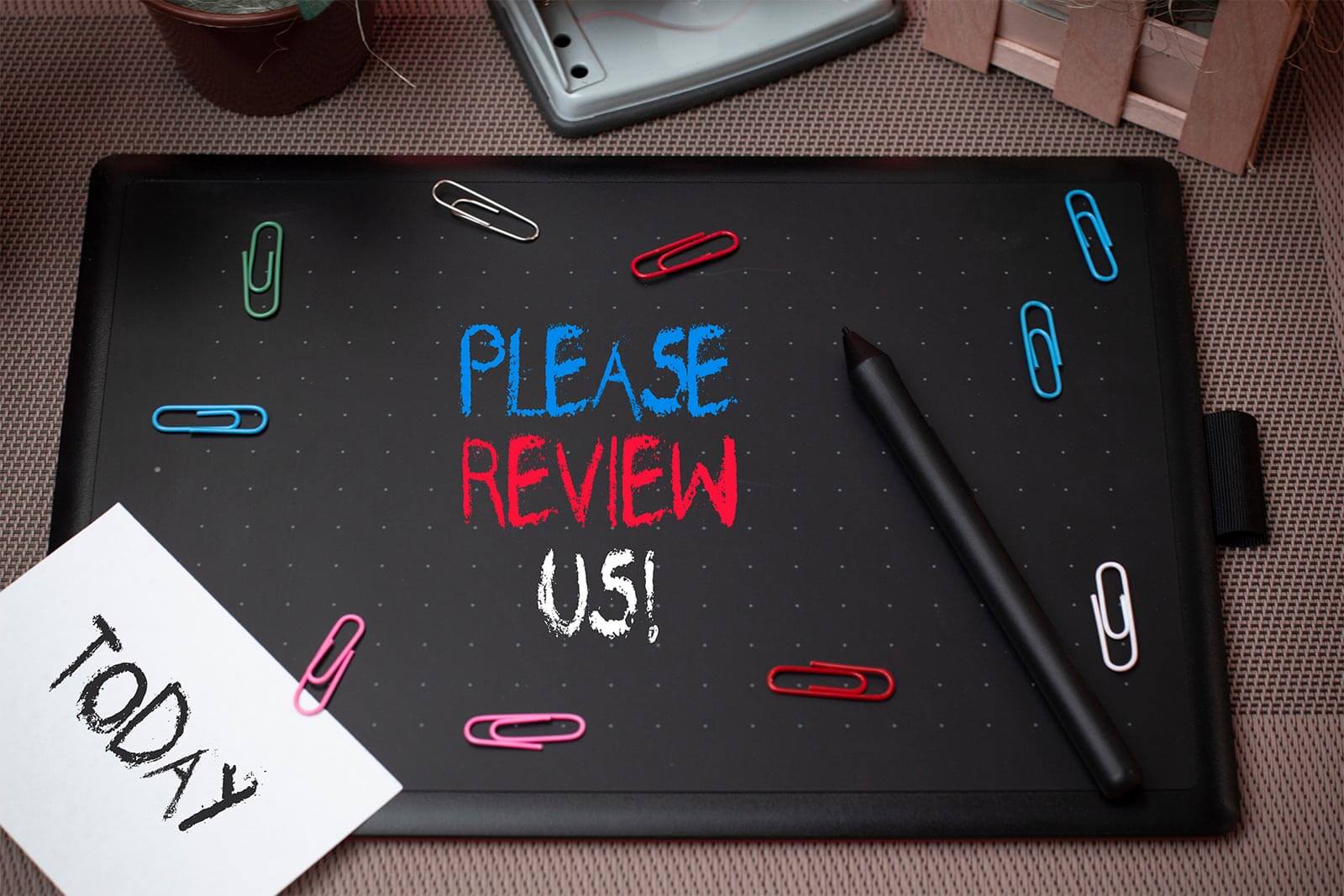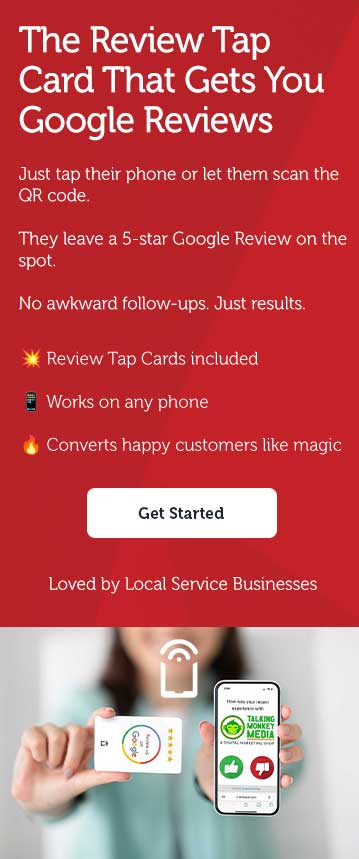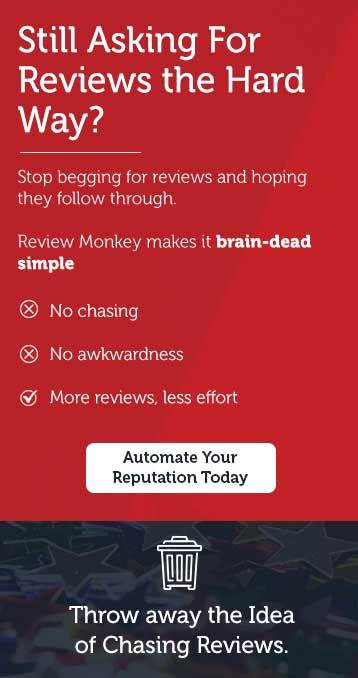Review Management 101
The Art of Increasing and Maximizing Your Positive Online Reviews
1. Providing Amazing Customer Service

If you want 5-Star Google Reviews, it all starts with providing 5-star service. The first step in Review Management is providing fantastic customer service. Review Management is increasing your positive reviews and then capitalizing on those reviews to generate new business and traction.
You have a lot to juggle when you’re a business owner. This could include driving sales, increasing your marketing efforts, building brand awareness, expanding your online presence, or hiring new staff members. However, one goal that should outrank the others is to provide fantastic customer service. Your customers are your lifeblood and can turn into life-long patrons if they leave with a positive impression of your store or services. Unfortunately, customer experience can get lost in the daily shuffle, and what’s worse, one negative review can have a lasting impact on an otherwise positive brand.
This Review Management 101 guide will outline several tips for going above and beyond for your customers during the selling and buying processes. It will also do a deep dive into how you should go about requesting customer feedback without seeming pushy or inauthentic, instead letting reviews come about naturally. While you can’t always control your customers, you can control how you approach serving them.
1. Have a Deep Knowledge of your Products & Brand
You can only sell if you know what you’re selling. Your brand is unique, and your products reflect the story of your business. Please ensure you know your products and services inside out and that your sales representatives understand this, too. This is the best way to field any tough questions and articulate answers in a way that leaves customers satisfied. If customers feel you love and believe in your products, they will, too.
2. Be Friendly and Say Thank You
There’s nothing worse than going to a store and feeling unwelcome. You and your representatives should greet every new customer with a smile and warm welcome as they come in. This will help make them feel more comfortable and interested. If a customer is still waiting to buy something that day, thank them or incentivize them to return another time.
3. Train Your Staff
You can’t be at your business 24/7, so please ensure you’ve properly trained and prepped your staff for all customer service situations. After all, your reps are a reflection of you and your business. If you want them to talk to or interact with customers in a specific way, you must give them the right tools and training to assist efficiently and effectively.
4. Listen & Be Respectful
Refrain from assuming you know what a customer is looking for or how they feel. If a customer complains, take the time to hear them out sincerely and don’t let emotions get in the way of righting the situation. Be courteous, respectful, and responsive.
5. Maintain a Positive Attitude
Sometimes, even after you’ve taken all the above steps, you’ll get a customer who is downright rude or just having a bad day. All you can do is maintain a positive attitude and attempt to solve the problem as best as possible. If you’re attempting to solve an issue over email or chat, sometimes picking up the phone and talking one-on-one can go a long way.
6. Ask for Feedback
I think the most important tip on this list is that asking for feedback is the best way to identify specific areas for improvement and check in with your customers on how you did.
So, how should you go about requesting customer feedback? You don’t want to be too pushy, but many customers must remember to leave reviews, even when they’ve had a good experience. Unfortunately, often, the bad reviewers are the ones who remember. Keep reading to understand how you can increase organic, positive reviews coming to your business.
Asking for Feedback
Any business leaves itself slightly vulnerable when asking for opinions on its products, services, and the business itself. No one wants to hear they didn’t rise to the occasion. But you may be surprised to learn that feedback is a great way to incorporate new ideas and opportunities into your business, add a new product line, or handle things differently at checkout, making your business that much better. In addition, simply asking, “How did we do?” shows the customer that you genuinely care about them and their opinions and want to incorporate their feedback.
There are several different ways to ask for feedback. You can send out customer surveys, feedback forms, and questionnaires or ask customers first-hand for feedback as they checkout. The best way to receive customer feedback is actually to use it! Make sure you’re regularly reviewing your feedback and analyzing for common trends. See what could be done differently if you get multiple reviews about a specific part of the buying or ordering process. Or, if negative feedback comes about, please reach out to the person as soon as possible to fix the issue and encourage them to return. We get more into how to handle feedback in Part 2 of our Review Management 101 Series.
Many businesses need help with asking for feedback or remembering to do it at all. If your business is growing, you may wonder how to reach out to all your new customers. Automating the review process is a great way to make it more effective. Review Monkey manages the entire review process by closing the customer experience loop with a simple, automated “How did we do?” Review Monkey sends an immediate text or email to a customer after they’ve purchased a product or service, evaluating the customer’s experience. Customers who had a positive experience are encouraged to leave a review and are directed to an easy place to do so. Customers who had a negative experience are asked to leave real-time feedback. This allows you to amend the customer’s bad experience immediately. Overall, automating the review process increases real, positive online reviews with minimal effort on your part. Online reviews are vital to the health and success of your business, and a plethora of good reviews is a fantastic way to show the world that you value excellent customer service.
2. After the sale – Engaging and Asking for Customer Feedback

It goes a long way to ask a customer, ‘How did it go?’ It shows you want to know; it shows you care. Business owners sometimes fear asking, but it’s essential for improving how to get more Google reviews and avoid exposing themselves to negativity.”
Customer Feedback: Keeping it Short, Simple, and Seamless
For many business owners, the end sale is the ultimate goal. There’s no better feeling than when a brand-new customer buys a product and, in turn, becomes a lifelong client. Many business owners may also believe that the work is done after the sale. However, there are several ways to optimize customer engagement and boost your brand’s visibility even after the customer has left the store, leaving them with a positive impression and enticing them to come back with and experience fantastic customer service. One of these ways is by engaging and asking for feedback online. Feedback and online reviews are some of the best ways to scale your local search engine optimization ratings on search engines like Google. Utilizing online reputation management and SEO reputation management strategies can lend credibility to your business and mission, solidifying your place at the top of your industry.
Why should I ask for feedback?
As a business, you should constantly be improving and looking to explore new possibilities. Constructive feedback is the best way to understand what’s working and what isn’t and how you can continue to deliver your best in every interaction. Asking for feedback also makes the customers feel valued, influential, and involved. There is actual vulnerability, humility, and authenticity in asking for genuine feedback, and your customers will feel closer to your business and your mission because of it. You are communicating that you care about how the customer feels and that they are directly helping your business get better.
However, the key to asking for feedback is to use it. There’s no value in generating reviews if you don’t implement the feedback for the next sale or customer experience. Be consistent in reviewing your feedback and take each review seriously, showing your customers you’re listening and working for them. Even negative reviews will help your business change, grow, and improve.
Other benefits in asking for feedback
Customers are inundated with products, services, and advertisements for them almost every second of every day. So, how do you break through the noise? You guessed it: asking for feedback! When a customer leaves a review, you are making an impression that will allow them to remember you for the next time around. Staying top of mind is crucial for businesses trying to make a name for themselves. In addition, if a customer can easily recall a positive experience they went out of their way to leave a review for, they’re more than likely to recommend it to someone else. Word-of-mouth marketing still trumps most forms of digital advertising and content marketing. New customers who see other happy online reviews will feel more confident using your business and buying your products.
When should I ask for feedback?
In short, ask your customer for feedback as soon as possible. Getting a customer to leave a positive review while the sale is still hot and the customer is still happy is crucial. The longer you take to ask for feedback, the stronger the possibility they’ll forget about the positive interaction entirely, or worse, forget to visit your store the next time or share their experience with others. Closing the engagement gap quickly will help let the customer know you truly valued the experience as much as they did and that you care to hear their thoughts.
How should I ask for feedback?
The review process should be quick, automatic, and painless on the customer’s side. No one likes filling out lengthy online forms or being forced to hit multiple characters or word counts. As a business, you’d also want to avoid being too pushy. Feedback is great, but asking for too much and asking too many times may turn the customer off from coming back or, worse, lead them to write a negative review. You can always opt for the more straightforward route: asking for a line or two of feedback and gently pushing once if you don’t hear back from the customer the first time around. Luckily, there’s a way to automate this process so the entire review and feedback cycle is taken out of your hands. You’ll be free to focus on daily business operations while earning crucial feedback as seamlessly as possible.
Using Review Monkey
Suppose you would like more reviews but would need to learn how to actively encourage them from your customers. In that case, you can benefit from a simple, effective, automated review feedback process. That’s where Review Monkey comes in. Review Monkey’s advanced software helps you generate more positive reviews while getting ahead of the negative ones before they’re posted. Review Monkey implements a review funnel for every completed service by sending an automated request for feedback. If the customer reports a great experience, Review Monkey asks for feedback and sends a gentle reminder text or email if needed. Suppose a customer had an issue with the service. In that case, Review Monkey politely asks them to share their experience, allowing you to amend the issue before the customer leaves a formal review. Review Monkey also holds and tracks a database of your previous reviewers so you can continue to optimize your visibility.
You’ve established the how, when, and why in your review process, so let Review Monkey automate it with the right tools. This will help you close the customer feedback process loop and increase your positive reviews without lifting a finger.
3. Handling Feedback: Embrace the Positive, Address the Negative

Most business owners will tell you the cornerstone of a successful business is a happy customer. Sure, financial health and long-term goal achievement are just as significant, but your product, service, or overall business will only make it very far if customer service is always in your mind. Satisfied clients, in turn, create loyal customers who will come back again and again. According to a 2020 Ameritas study, a loyal customer, on average, is 10 times more valuable than their first purchase. In addition, about 97% of customers will tell others about very good or excellent customer service experiences, making online review management and customer feedback examples crucial for building repeat business. The numbers here speak for themselves. The value of turning a new buyer into a repeat one far outweighs the value of a customer buying one product and never returning.
We got into the topic of providing fantastic customer service. Next up was asking for customer feedback. Now, we will get into how you should receive feedback when it does come back, specifically focusing on optimizing this feedback for the most significant ROI. If you’re a business owner, you most likely know that a constant feedback loop is incredibly crucial. But did you know that negative feedback is just as important, if not more important, than positive feedback? Receiving negative feedback is an excellent opportunity to evaluate processes, including understanding how to respond to negative reviews or handling fake Google reviews, and improving your business strategies. So, how should you receive positive and negative feedback and use it to your advantage?
Embrace the Positive
1. Say Thank You
Believe it or not, many customers only voice feedback when dissatisfied. Positive feedback is a sparkling gem in your business crown and should be treated as such. After you receive positive feedback, always give a heartfelt thank you. Please let them know that they decided to shop at your business and give you direct feedback on a well-done job.
2. Personalize your message as much as possible
Generic responses are fine for you as you build your overall feedback strategy, but I want to give each response a personal touch. Could you address the person by name and reference specifics if you remember the interaction? It’ll entice the customer to return if they feel personally valued and not just seen as another transaction.
3. Ask for a formal online review
Ask your happy customer to go the extra step and leave a positive online review. Using review management software is one way to streamline how to get more Google reviews and boost your ratings.
Address the Negative
1. Apologize and say thank you
No one likes receiving negative feedback, and most people hate apologizing even more when they think they’ve done nothing wrong. Unfortunately, when responding to negative feedback, the best action is to be humble and polite. I apologize for what you and your business have control over first, and I thank the unhappy customer for choosing your business and their honest feedback.
2. Be polite
You may be tempted to point fingers and even name-call the person who left negative feedback. But remember, what’s said online is open to everyone and, unfortunately, permanent. One hot-headed moment could live on the internet forever, or worse, go viral. Please don’t argue with a customer or blame them for their experience. Most customers who have bad experiences want to feel like they’re being heard. Seek to come from a place of understanding and keep your language appropriate.
3. Provide contact information
You can respond to negative feedback first, but please don’t go back and forth with the person on a public site or in your physical store for everyone to see, if you don’t mind. Please give them your personal or business information and ask them to contact you. Also, ask them to provide more details about the unhappy experience. Lastly, collect your information. Ask your staff members if they remember the unhappy customer and try to get to the root of the problem.
4. Right the wrong if and as soon as possible
Time is of the essence when addressing negative feedback. You can turn their experience into a positive one, but only if you act quickly and urgently. The faster you act, the more likely the person is to change their view to a favorable one and appreciate your dedication to customer service.
5. Keep it short
You don’t need to respond to either positive or negative feedback that is long and complicated. Please keep it to the point and precise. Don’t say more than what is absolutely needed when addressing negative feedback.
And, as always, be as proactive as possible. The shorter you take to address and implement constructive feedback, the more valued the customer will feel. Could you follow up where you can and stay true to your customer commitments? As with all feedback, please don’t take it personally. See it as an opportunity to grow, improve, and shake things up to keep it fresh.
4. Asking for the Review. Do it Fast & Make it Easy.

Everyone loves positive feedback. Getting a shining performance review, a “well done” response on an excellent paper or assignment, or even a simple “thank you” can make our day. Positive feedback reinforces that your ideas are appreciated, your services and products work well, and your brand is well-received by your customers. If you run a business, you know the value of positive feedback, which keeps you in business and generates new customers. However, asking for and receiving positive feedback can be more challenging than it seems. You may have a customer leave with a smile, but that’s no guarantee they’ll leave a positive review. Here’s why positive feedback and online reviews are so critical.
According to Invespro.com, nearly 9 in 10 consumers treat an online review like they do a personal recommendation. In addition, customers are likely to spend 31% more on a business with “excellent” reviews, and 72% say that positive reviews make them trust a local business more, prompting them to take action. Teaching customers how to leave a Google review and using strategies to increase Google reviews are essential steps in building that trust. It’s no secret that seeing a business with at least four stars on Google, for example, will lend better to enticing new customers than one with a two-star. In addition, with search engine optimization, more reviews will rank your business higher in the search algorithm. This gives you more exposure and credibility in your industry.
Everyone would love more positive customer reviews, but it takes a little thought and planning. In addition, automating the customer review process can take your feedback strategy to the next level, streamlining your operations, generating more reviews, and leaving you to focus on day-to-day business responsibilities. So, when should you ask for a formal review after getting positive feedback?
The short answer is as soon as possible. It is critical to ask a customer to leave a review when they’re hot and happy and your business is at the top of your mind. Customers are busy. Even if they fondly remember their interaction with you or your services, they may forget to leave a formal review or think it isn’t unnecessary. Getting a customer to leave a positive review as soon as they step out of the door is critical, as this is when they remember the interaction with as much detail as possible, including what they bought, who helped them, and how they felt about the service. This is when they’re happiest because they either just bought a great new product or are extremely satisfied with their service.
So, how can you get a customer to leave a positive review? Follow these few steps, and you’ll be on your way:
1. Direct customers to the right spot with ease – don’t make it a hunt
No one likes clicking through multiple form pages or filling out endless text boxes with required character counts. Again, customers are busy. Please make leaving a review as accessible and findable as possible. When you ask for an online review, you can direct a customer to the spot to leave feedback. Don’t first redirect them to your website or make them create an account with a third-party review system. The less time it takes a customer to leave a review and the easier it is for them to find the place to do it, the more likely they will give formal, positive feedback.
2. Make the process repeatable
Every customer should be taken to the same review process again and again. You should have one standard review platform database that feeds in all your feedback, saves it, and tracks who has and hasn’t left a review. Pointing customers to different review platforms or merely asking for verbal feedback may confuse new customers or incorrectly capture their feedback.
3. Automate the process – and use it
A great way to take your review strategy to the next level is by completely automating and streamlining the process. Using a straightforward platform to send out review reminders, track reviews, and painlessly collect feedback will make your life easier and make your customers happier. One way to do this is by using Review Monkey, a browser-based app that helps businesses and professionals increase their REAL positive online reviews. Review Monkey helps manage the SEO reputation management aspect of your business while increasing positive online reviews. Review Monkey creates a review funnel for your business after you sell a product or complete a service, asking the customer about their experience. Review Monkey automatically asks the customer to leave a review and gently follows up via text or email if they need reminding. Suppose the customer had an issue with their experience. In that case, the Review Monkey software asks the customer to explain what went wrong, allowing you to fix the situation before they leave a formal review. In addition, the Review Monkey software tracks who has already left a review and who has opted out of receiving messages, allowing you to reach new audiences instead of targeting older customers.
Review Monkey helps create a positive impression of your business by increasing the genuine, genuinely happy reviews left for your products or services online. Review Monkey also helps you avoid negative reviews before they’re published, allowing you to amend the situation before it impacts new business. Using software like Review Monkey will make the process seamless and automatic, allowing you to get more reviews with little work or interruption to business processes.
5. Respond to all Reviews

Responding to Reviews isn’t Recommended; it’s a Requirement. While it might be daunting, responding to Positive AND Negative reviews is a MUST. We’ve asked for the review, and now we must respond.
A bad online business review can be challenging to handle. These types of critical reactions may seem like personal attacks on not only your business but also on your character. Whenever you provide a customer with a good service, you open yourself up to feedback, and you should see every review as a chance to learn and improve. If you’re a new business owner or would like to increase the reviews you get, you should start with two foundational reviewing strategies. These include having oversight on every negative review AND responding to every negative or positive review.
How to respond to reviews: what should you say?
Responding to every customer review may sound daunting at first. However, responding to a review is a simple and effective way to boost your online reputation and strengthen your marketing efforts with little effort. A 2018 Harvard Business Review article found that replying to every review generally resulted in better business ratings. This strategy needs to be utilized more, but it can make all the difference, especially when you’re just starting to build a customer base. Responding to reviews should be a requirement for every business, but don’t see it as another thing to check off your list. Use it to connect with your customers, show them you care, or even incentivize future purchases.
Responding to negative views is also essential. This can help solidify your online reputation and boost your overall engagement. If a bad review goes ignored, your customers may read it and assume it’s true. They may also think you don’t care that a customer had a bad experience, which reflects poorly on your character and your business’s values. You may also miss a chance to correct the bad experience, which could have resulted in the customer taking the review down.
Responding to positive reviews
Respond to positive reviews as soon as possible – If you write a response sooner rather than later, your reply will seem more genuine and attentive. Your customers will feel you genuinely care about feedback and want to visit again. Start by thanking the customer for their kind words and taking the time to review your business. Use their name directly and be concise.
Responding to negative reviews
Like positive reviews, responding to negative reviews as soon as possible is crucial. You may be upset or believe the customer is wrong, but keeping your cool is important. Be prepared to write a short, non-confrontational reply. Here’s a couple of steps you can take:
- Reassure them that their feedback, however harsh, is valued.
- Remind the customer that you thoroughly understand their issue using specific keywords from their review.
- Leave them with your best contact details and a call to action that indicates you’d like to help resolve their issue and discuss things further.
- Avoid signing off with your business name, as this is more likely to show up in search engine results
How to respond to reviews on Google, Facebook & TrustPilot
Google is the world’s most popular search engine, and with millions of people checking and reviewing listings daily, your Google My Business rating is critical. Google requires consistent monitoring. Using online reputation management tools and understanding how to report fake reviews on Google can make the process smoother. In addition, positive reviews can greatly improve your Google SEO ranking or how you map in search. Here’s how to respond to reviews using Google:
- Sign in to your Google My Business by going to business.google.com.
- Click the three horizontal bars in the top left-hand corner to find your business listing.
- Click “Manage Reviews.” Scroll to find the review you’d like to reply with, and click “view and reply.” You can then type out a response if you’d like.
The customer may reply to your review, so be prepared for a follow-up. You can set this up through the platform if you’d like to receive a notification when a new review is posted through Google My Business.
Facebook has transformed from a social networking site into a full-fledged marketing and advertising tool for businesses. Facebook Business Suite now offers a whole host of business manager tools to take your customer engagement to the next level. If you receive a negative comment, you can hide or delete it. But you can’t remove negative reviews altogether. You can manage your business’s Facebook page on Facebook Business Manager.
- Make sure your Facebook Business Page is set up, and the review feature is toggled to “on.”
- Once reviews start coming in, you’ll be able to reply to them by clicking “reviews” on the left-hand side of your timeline.
- Below a review, hit reply and type out a response. Just to let you know, depending on the reviewer’s privacy settings, you may not be able to reply directly to them.
TrustPilot
While Facebook and Google are two of the most popular review sites, TrustPilot is also where you should monitor reviews.
- First, navigate to the Trustpilot Business feature and go to the reviews tab on the left-hand side. You can either reply to a service review or a product review.
- All your customer reviews are under “Inbox.” Navigate to the review you’d like to respond to and hit “Reply.”
- Type your reply in the drop-down box. Be kind, concise, and direct; thank positive reviewers for their time, and ensure negative reviewers you are taking their concerns seriously.
Are you doing all you can to engage your customers and encourage them to leave behind positive reviews? Are you replying to negative reviews and asking for more feedback? Review Monkey can help streamline the process, showing customers you care with a simple, automated “How did we do” text or email.
6. Marketing Positive Reviews

There’s no doubt that positive customer reviews are a great way to boost your business’s credibility, visibility, and overall brand status in your industry. If someone Googles your business and sees many positive reviews left by satisfied customers like them, they’re more inclined to patronize it. According to a 2014 study conducted by Brightlocal, 88% of customers read reviews to determine the quality of a local business and 72% of consumers say that positive reviews make them trust a local business more. As you can see, online reputation and review management are king in digital branding. Positive reviews can put your business on the map if marketed correctly. Using tools to get Google reviews and Google review software can further boost your SEO ratings.
how can you market your positive reviews and use them to your advantage? Here are six great ways to start.
1. You can display your reviews on your website with a widget or embedding.
Your positive reviews are something to be proud of, so they should be prominently displayed upfront and boldly on your website. Customers are likely to trust reviews with a name and perhaps a photo attached and spelled correctly and grammatically articulating. You can display reviews using a site widget or embed them with code. Could you do it on your homepage so it’s the first thing a new customer sees?
If you have a lot of reviews, you can even dedicate an entire page just to your customer testimonials. Reviews on your website will lend credibility to your site as a whole and answer your customer’s questions about your products and brand.
2. Create social posts out of positive reviews and post them regularly.
Whether your business is on Facebook, Instagram, LinkedIn, Twitter, or a combination, these social media platforms are where repeat customers and potential new buyers engage. Satisfied customers may leave reviews on your social media platforms directly on specific products or services. Could you allocate your best ones and turn these into social posts to share on your platform?
You can even turn your reviews into an engaging video for an added boost. Recent data shows that digital videos and video testimonials are a great way to garner engagement on social media. Luckily, with widespread advancements in video technology, great online tools exist to edit and design your customer review video yourself.
3. Share reviews in promotional emails
If you already have an email database of customers who have bought from you before, include positive reviews in your promotional emails. Because the average person receives almost 100 emails daily, making yours stand out is essential. A rave review from a verified customer may entice them to click on the email and check out your new promo or discount.
4. Respond to all reviews as quickly as possible
As discussed in previous steps in our Review Management 101 series, responding to all online reviews, whether positive or negative, is crucial for your online reputation management. This shows you care about your customers, their patronage, and what they have to say. I’d appreciate it if you responded to reviews quickly and helped avoid any lousy customer experience before it escalated, showing an unhappy customer you are willing to go the extra mile to fix their complaint. And responding to your positive reviews will also lend to your reputation as a brand that is truly grateful to its customers.
5. Make it easy for customers to review
No one likes to fill out long, confusing forms, especially a happy customer looking to leave a positive review. In turn, their positive experience may become negative if too much information is asked of them or if they feel they need to jump through hoops. Could you make the review process as easy and quick as possible so that you receive more reviews and attract new ratings? You can also attach a quick “How did we do?” survey to your website after a customer completes a purchase or uses your customer service line.
One great way to receive more genuine reviews and make the review process seamless and easy is to automate it. Review Monkey, a browser-based app, helps businesses and professionals increase their REAL positive online reviews by “closing the customer feedback loop” after the sale. Review Monkey creates a review funnel for your business after you sell a product or complete a service, automatically asking the customer to leave a review and gently following up via text or email if they need reminding. If the customer had an issue with their experience, Review Monkey asks the customer to explain what went wrong before leaving an online review, allowing you to fix the problem. Review Monkey software also tracks who has left a review and opted out of receiving messages, allowing you to reach new audiences.
6. Good old word-of-mouth marketing
Sometimes, the best way to promote and market your positive reviews is to discuss them with others! Tell satisfied customers to tell their friends about their happy experiences or even put flyers up around town. If a customer comes in with a request or problem to one you’ve previously experienced with another customer, relay the story with credibility and authenticity, describing what you did for them and how it could help in this scenario.
A core principle of online reputation management is that customers will only sometimes believe your business, products, or services are the best in the world if they hear from you. But, they may be more persuaded if they hear it from someone else. If you’re looking to boost your online reputation management strategy, starting with review management is a great way to support your growing brand. Automating this process will help make getting reviews seamless and easy, allowing you to focus on day-to-day operations and building the best business possible.
Book a Live Demo of Review Monkey
 Get Your Copy
Get Your Copy





